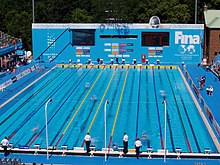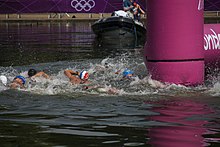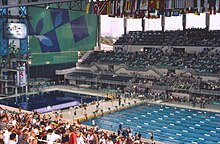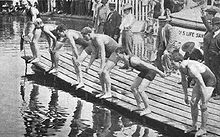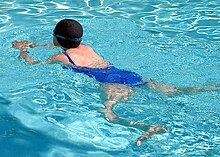Swimming
Swimming is the practice of swimming as a sporting discipline. In its basic form, the swimming sport is carried out as a competition between several participants to master a specified swimming distance in the shortest possible time, or without time pressure to improve one's own swimming technique.
History of swimming
Numerous researchers have dealt with the question of the development of modern swimming techniques in the past. Everard Digby wrote the book De arte natandi as early as 1587, and in 1696 Melchisédech Thévenot published L'Art de nager (“The Art of Swimming”) in Paris . Because of this book, the breaststroke technique was long preferred in France (and Europe).
In 1798 Johann Christoph Friedrich GutsMuths published his book on the art of swimming, which can be seen as groundbreaking for the later attempts of the Halloren (salt workers) to methodize learning to swim. Since the Halloren had found that it is easier to swim in the salty brine, the way to the technically feasible motor skills of the movements described very schematically in the swimming book was paved. The manikin-like movements that GutsMuths represented were, however, hardly suitable for developing a useful swimming technique.
Modern competitive swimming developed in London's indoor swimming pools around 1837 . The swim was either breaststroke or side swim . In 1895, the Englishman JH Thayers swam the 100 yards in 1: 02.50 minutes (corresponds to 5.26 km / h) using side technique. Until the 1950s, the breaststroke, which is usually the first technique to be learned, was the only type of swimming for which precise rules were set.
Sir John Arthur Trudgen developed hand-over-hand swimming in England in 1873, which was then called "trudgen". The arms were brought forward out of the water, similar to side swimming, only you always switched from one side to the other and performed additional scissor-leg strokes. The Australian swimmer Frederick Lane "trudged" the 100 yards in 1: 00.0 minutes in 1901.
Instead of the inharmonious "Trudgens", the Australian Richard Cavill used the more fluid technique of the indigenous people of the Solomon Islands . These combined the crawl kick with the alternating overwater arm pull on both sides. With this technique known as the "Australian Crawl", Cavill achieved a world record time of 58.4 seconds over 100 yards in 1902.
In 1934, David Armbruster, a trainer at the University of Iowa , found that both arms could be returned to the front while swimming in the breaststroke. This "crashing" increased the swimming speed, but cost more training and stamina. In 1935, Jack Sieg, also from the University of Iowa, swam on his side, flapping his legs like a fishtail. He could do it on his stomach, after all. Armbruster and win the combined Spiking of the arms and the leg impact, thus creating the first "Butterfly" ( butterfly ) said swimming technique. With two leg kicks with every arm stroke, Sieg swam the 100 yards in 1: 00.2 min. According to other sources, it was an American named Brydenthal who swam this technique for the first time in 1935. The "butterfly breaststroke", initially considered illegal, was only legalized in 1953 as a separate competitive swimming type.
Swimming competitions
Swimming has been part of the Olympic program since the first modern Olympic Games (1896 in Athens ). At the second Olympic Games in Paris in 1900 , an obstacle swim, an underwater endurance swim and a 4,000 meter swim were held. With the exception of the latter ( long-distance swimming ), these forms of competition were no longer carried out later. At the Olympic Games in 1912 , women were allowed to take part in the competitions for the first time. Official swimming world championships have been held since 1973 . Swimming competitions are generally held according to the rules of the international swimming federation Fédération Internationale de Natation (FINA).
venue
The venue is for stretches up to 1500 m swimming pools that meet the various requirements in terms of lane length (25 m or 50 m), lane width (2.50 m), water depth (at least 1.60 m, at Olympic Games and World Championships at least 2 m) Water temperature (usually 25–28 ° C). The lanes are separated from each other by lines that are supposed to keep the waves away from the neighboring lanes - which swimmers often call "wave killer lines" or " breakwaters ". The lines have different markings: in the 5 m area in front of each pool wall (in these areas the lines are usually red throughout), in the middle and at 15 m each. On the floor there is also often a 25 cm wide black line in the middle of each lane, which forms a T 2 m from the end of the pool and helps the swimmer to orient himself. There are also other lines hanging over the pool: 5 m in front of each pool wall there is a flag line (at least 1.8 m high) to show the back swimmers that the wall is approaching. There is also the false launch line, which hangs 15 m from the start (at least 1.2 m high). This will be let into the water if the referee or starter detect a false start . Both indoor and outdoor pools are used for competitions. In general, people swim in freshwater pools, but there are still a few saltwater pools where competitions are held.
stretch
The courses are swum in accordance with the regulations, which are usually a multiple of 100 meter sections: 100 m, 200 m, 400 m, 800 m, 1500 m and 5000 m as well as the 50 m distance as a sprint course. When long-distance swimming routes are 5-25 km added, which are usually held in open waters. In addition to individual competitions, relay competitions also take place, with only four-person relays being swum here. Internationally there are relay competitions over 4 × 50 m, 4 × 100 m and 4 × 200 m.
Lanes
A distinction is made between the 25 m short course and the 50 m long course, for which different world record lists are kept. In competitions, there is a maximum of as many swimmers as there are lanes in the pool. Exceptions are over 1500 m, 800 m and 400 m freestyle, where two swimmers per lane can compete in smaller competitions. Eight lanes are normally provided for a competition pool. In elimination competitions, therefore, several runs are held in which the swimmers are allowed to participate in the next elimination stage if they have achieved the positions required by the regulations. The fastest registered or qualified swimmer always starts on lane 4, the second fastest swimmer follows on lane 5, then it goes on via lanes 3, 6, 2, 7, 1 to lane 8, on which the slowest swimmer of the run swims. In competitions, lanes 4 and 5 are usually bordered by yellow lines to identify the two strongest swimmers.
begin
After the start signal, the swimmers start from the raised starting blocks of their swimming lane at the pool head by jumping into the water (except for the backstroke and the individual relay , where the backswimmer starts in the water). In the event of a false start (sensors in the starting blocks help the referees in modern swimming pools), those swimmers who triggered the false start (provoked) or jumped off too early will be disqualified after the race (a wobble on the starting block is enough).
In the case of relays, except for the first swimmer, one speaks of "flying changes". The following swimmer may start a maximum of three hundredths of a second before the actual stop of the leading swimmer. Since there is no reaction time with flying changes, relay swimmers are often a little faster than in an individual competition. Times swim here are not recognized as individual records, with the exception of the time of the starting swimmer. Relay records apply to routes calculated from the start, provided that the relay finishes the competition properly. The first four swimmers in a 10 × 100 m freestyle relay can swim a relay record over the 4 × 100 m.
swim
The technique of locomotion is given by the naming of the competition swimming type and is subject to differentiated definitions of the regulations. As many lanes are swum as the given route requires. The swimmer makes a turn in the water at each end of the lane and swims back in the opposite direction. On the 800 m and 1500 m freestyle courses, the lanes are counted and displayed for each swimmer, sometimes even with displays under water. In addition, from freestyle distances over 800 m, the turn judge must use acoustic signals (whistle, horn etc.) to make it clear to the swimmer when there are still two lanes and five meters to swim. This unifies this practice on short and long courses.
attack
The time is stopped the moment the swimmer touches the wall (in freestyle and backstroke swimming with any part of his body, in breast and butterfly swimming with both hands at the same time on, above or below the surface of the water and not on top of each other). For relays, the intermediate times after each relay swimmer and the end time are taken. In large competitions, measurements are usually carried out electronically, and the stop mats (mostly yellow or white) react to the slightest force. In addition, the times of at least one person per lane are recorded manually (semi-electronically). In addition to electronic and semi-electronic timing, system-independent timing must be carried out by a referee with a stopwatch or by video timing. In cases of doubt, the finish court evaluates the finish. It can happen that athletes with the same time get different placements if the target court was able to recognize the order of the attack. If there is a properly registered electronic time, this is the official time and will not be changed. The finish judge's decision only comes into play if there are no error-free electronic times and the established run-in contradicts the times that were manually timed.
training
Technical exercises
Technical exercises in swimming lead to an optimization of the swimming position, which is reflected in improved body control in the water. At the same time, you prevent injuries in sports.
Through various exercises you learn your position in the water, your arm or leg movements, or general body coordination, body tension and correct breathing (especially in competitive sports). It is important to take breaks between the individual exercises and their repetitions. The length of the breaks is determined by the frequency and type of exercise. Each exercise has its own level of difficulty in terms of strength, coordination and flexibility. The more demanding the exercise, the more skills need to be accessed at the same time. Therefore, an individually adapted break design is important.
Use of tools
By means of auxiliary items, e.g. B. paddles or fins (short or long), effort and water position can be changed significantly within certain exercises. Paddles allow a better feeling of water in terms of pulling and pushing phases of an arm stroke; Fins convey a better feeling of movement for the leg kick (crawl, back and dolphin / butterfly). They are not allowed in competition. With the help of swimming boards , the leg muscles and with Pull Buoys the arm muscles can be trained separately.
Only swimming goggles and a maximum of two swimming caps are permitted as aids in the competition.
clothing
Optimal gliding is essential for high speeds in swimming. For a long time, textile fabrics were inferior to human skin in terms of their sliding properties, so that clothing with a particularly short cut was preferred. A shave of the body hair was and is also used.
Head hair is hidden under swimming caps, which are made of latex or silicone in the competition area. The smooth surface of these materials has relatively good flow properties. With so-called 3D caps, folds of the cap are avoided by their shape and cut. A modern alternative are fabric caps coated with plastic.
Inspired by the good flow properties of the skin of a shark , the manufacturer Speedo initiated a technological evolution in clothing. For the first time, this enabled better flow properties than human skin without generating additional lift, which is not allowed in competition areas. In the course of technical development, swimsuits were developed, essentially in short skin (covering the thighs), leg skin (covering the legs), body (covering the legs and upper body) and full body (covering the entire body with the exception of the Feet, hands and the head / neck area). Optimal gliding is only achieved with textile suits when they are very tight on the body. This compression can lead to constrictions, so that extremely tight suits are only worn for short swimming distances and some swimmers also do without covering the upper body. The compression of the body by extremely tight-fitting suits can be perceived as a hindrance on the one hand, but on the other hand it can support muscle contraction and relaxation .
From diving and triathlon it was known that neoprene suits have extremely good sliding properties. In these types of sport, the use of buoyancy-enhancing materials is partially permitted, so that neoprene is not only used for thermal insulation, but also for buoyancy. Only the technological development of an extremely thinly applied neoprene material with negligible own buoyancy made it possible to use such materials in swimming, where they displaced other materials due to their outstanding gliding properties. This led to a large number of new records on all competition courses. It must be viewed critically that the air-impermeable materials allow air inclusions that bring additional buoyancy. For this reason, the international swimming federation FINA banned the wearing of two suits on top of each other in 2009. This also includes simple swimming trunks under such a high-tech suit.
The choice of speed-promoting clothing in high-performance swimming attracted increasing attention. Manufacturing companies kept working on new improvements to the material and cut of swimwear. This led to a discussion about the need for FINA to regulate high-tech swimsuits , since the right clothing had become increasingly relevant for competition, and ultimately to a complete ban on swimsuits in their previous form. The FINA stipulated that from 2010 swimwear in competitions may no longer be longer than knee height. In addition, the men are not allowed to wear clothing that covers the upper body. Zippers are prohibited.
Swimming techniques
Swimming technique is the standardized type of swimming prescribed by the official rules and applicable to all competitive swimmers. As swimming style is defined as the individual characteristics of each technology. The most popular modern swimming techniques today are breaststroke , crawl swimming , back crawl and butterfly swimming (dolphin swimming). In competitive medley swimming , four equally long sections are completed in the order of butterfly, back, chest and freestyle swimming. However, if swimming in a medley relay , the order changes into back, chest, butterfly and freestyle. The freestyle leaves open the swimming style.
Older and seldom swimming techniques are side swimming and the old German back (also referred to by swimmers as back-long lay or back-glide pull). Also, the dynamic apnea is exercised as defined sport swimming technique. A distinction is made between several techniques for lifeguarding . In Japan, the samurai tradition has its own forms of swimming that are only used there.
Speeds
The following values are based on the current long-track world records for men on the respective 100 m distance (as of January 2013). Popular athletes are only about half as fast, inexperienced people can be significantly slower.
| Crawl (freestyle) | 2.13 m / s = 7.67 km / h |
|
46.91 s | July 30, 2009 |
| butterfly | 2.01 m / s = 7.23 km / h |
|
49.82 s | August 1, 2009 |
| move | 1.93 m / s = 6.93 km / h |
|
51.94 s | July 8, 2009 |
| chest | 1.73 m / s = 6.22 km / h |
|
57.55 s | August 6, 2016 |
Gender differences
As with most sports, there are gender differences in swimming . The best men swim 10-15% faster than the best women due to better physical fitness.
| discipline | record | difference |
|---|---|---|
| 50 m chest | 25.95 s |
12% |
| 29.48 s |
||
| 50 m back | 24.04 s |
13% |
| 27.06 s |
||
| 50 m freestyle | 20.26 s |
13% |
| 23.24 s |
Other swimming disciplines
Around the basis of distance swimming, swimming was further differentiated with playful and technical disciplines like that
- Aquaball
- Water polo
- Underwater rugby
- Underwater hockey
- Art and high diving
- Synchronized swimming
- Fin swimming
- Mermaiding
- Open water swimming / long distance swimming
- Lifeguard
- Clothes swimming
- Winter swimming
- Watsu and Wata
- Aqua aerobics
- Diving
- Military swimming (see Ernst von Pfuel )
Swimming is a basis for diving competitions , and a sub-discipline in triathlon and modern pentathlon .
Swimming and health
Swimming is one of the healthiest leisure activities and is also considered a sport with a low risk of injury. The static buoyancy in the water supports the body and significantly reduces the stress on the joints and bones . This allows movements that are neglected when exercising outside the water because of the stress and balance. The heart is relieved with moderate movement, as the water pressure facilitates the venous return flow. In addition, the water temperature has a stimulating effect on the circulation .
Almost all muscles are used when swimming , with the arms and upper body being trained more. However, the distribution also depends on the respective swimming style. Swimming is an aerobic activity in which the muscles are constantly supplied with oxygen . Swimming is suitable for people of all ages. There are special offers for small children where they can learn to swim, the so-called baby swimming .
The curative swimming uses the positive effects of swimming in the promotion of disabled people .
Organization of swimming
The global umbrella organization for swimming is the Fédération Internationale de Natation Amateur (FINA), which was founded in 1908.
The European associations are united in the LEN (Ligue Européenne de Natation).
In Germany, the associations that practice swimming are the German Swimming Association (DSV), the German Gymnastics Association (DTB), the Association of German Sports Divers (VDST), the Federal Association of German Swimming Masters (BDS), the German Life Rescue Society (DLRG) and the water rescue service in the DRK and the Arbeiter-Samariter-Bund amalgamated in the Federal Association for the Promotion of Swimming Training (BFS).
A league operation is also organized by the German Swimming Association, this is called the German Swimming Team Championships .
In Switzerland, the associations and institutions interested in swimming have come together to form the swimsports.ch association , formerly the Swiss Swimming Association (IVSCH). Furthermore, clubs that practice one or more of the four Olympic swimming sports are united in the Swiss Swimming Association (FSN). Lifeguarding is practiced within the Swiss Lifesaving Society (SLRG) with its local sections.
Known swimmers
An extensive list of internationally outstanding swimming athletes from 1965, broken down according to competition areas, is included in the record of the hall of fame of international swimming . In the Wikipedia article in question, the “ Members of Germany ” and “ Members of Austria ” are also listed separately for the German-speaking area .
As of 2016, swimming competitions are currently dominated by athletes from the USA and Australia . The first swimming star in the USA was Johnny Weissmüller , who was the first person to complete the 100-meter course in less than a minute and who later became known as the Tarzan actor. Michael Phelps broke the record of Mark Spitz , who won seven gold medals at the 1972 Olympic Games in Munich, with eight gold medals in Beijing in 2008 . In addition, Phelps is the most successful Olympian to date with a total of 28 Olympic medals. The most famous Australian swimmers are Ian Thorpe and Grant Hackett . The best Austrian swimmers are currently Mirna Jukic , Dinko Jukic and Markus Rogan .
Important German ex-swimmers are Klaus Steinbach , Werner Lampe , Hans Faßnacht , Michael Groß , Franziska van Almsick , the German double Olympic champion and multiple European champion Britta Steffen and Paul Biedermann , multiple world record holder, world champion and European champion. Erich Rademacher , who was born in Magdeburg in 1901 , set 30 world records between 1920 and 1927 and, in addition to a large number of swimming competitions, was also able to achieve victories with his team in water polo competitions.
See also
Web links
- Link catalog on swimming at curlie.org (formerly DMOZ )
- Series of images and animations for the swimming styles
Individual evidence
- ↑ De arte natandi libri duo: quorum prior regulas ipsius artis, posterior vero praxin demonstrationemque continet. Authore Euerardo Dygbeio Anglo in artibus Magistro. Londini: Excudebat Thomas Dawson 1587.
- ↑ a b Swimming Club Limmat Zurich: History of Swimming ( Memento from September 6, 2015 in the Internet Archive ), accessed on September 6, 2015.
- ↑ Evolution of the Australian Crawl ( Memento of March 6, 2014 in the Internet Archive ) Australian National Film and Sound Archive, video clip from 1952, accessed on October 18, 2015.
- ↑ § 101 competition pool ( Memento of the original from August 26, 2014 in the Internet Archive ) Info: The archive link was automatically inserted and not yet checked. Please check the original and archive link according to the instructions and then remove this notice. (English).
- ↑ DEUTSCHER SCHWIMM-VERBAND eV Swimming competition regulations Last update: January 2016 ( Memento of the original from August 8, 2016 in the Internet Archive ) Info: The archive link was inserted automatically and has not yet been checked. Please check the original and archive link according to the instructions and then remove this notice. .
- ↑ PR59 - FINA BUREAU MEETING ( Memento of the original from September 15, 2015 in the Internet Archive ) Info: The archive link was inserted automatically and has not yet been checked. Please check the original and archive link according to the instructions and then remove this notice. .
- ↑ Adidas Hydrofoil - Swim Suits Arms Race Continues .
- ↑ Bernd Steinle: The question of suit. The bandage floats . In: Frankfurter Allgemeine Zeitung . Retrieved June 25, 2009.
- ↑ List of swimming world records
